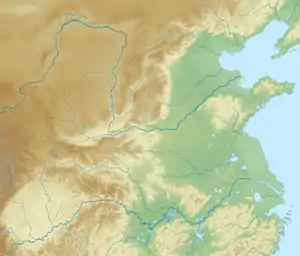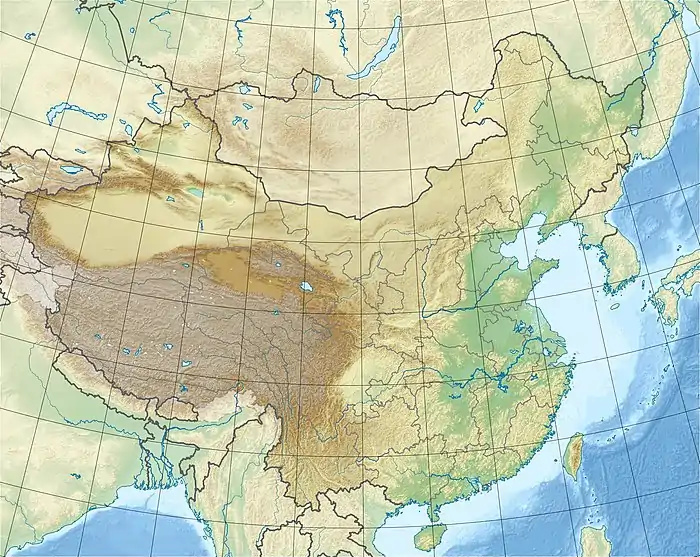Battle of Qianshi
The Battle of Qianshi (Chinese: 乾時之戰) was a military conflict between the armies of Qi and Lu that occurred in 685 BCE when Duke Zhuang of Lu (魯莊公) invaded Qi over a succession dispute.
| Battle of Qianshi (乾時之戰) | |||||||
|---|---|---|---|---|---|---|---|
| |||||||
| Belligerents | |||||||
| Qi | Lu | ||||||
| Commanders and leaders | |||||||
|
Duke Huan of Qi Bao Shuya |
Duke Zhuang of Lu Gongzi Jiu Guan Zhong (POW) | ||||||
| Strength | |||||||
| Unknown | Unknown | ||||||
| Casualties and losses | |||||||
| Unknown | Unknown | ||||||
 Location within Northern China  Battle of Qianshi (China) | |||||||
| Battle of Qianshi | |||||||
|---|---|---|---|---|---|---|---|
| Traditional Chinese | 乾時之戰 | ||||||
| Simplified Chinese | 乾时之战 | ||||||
| |||||||
Background
In the year 685 BCE, the Qi minister Yong Lin (雍廩) murdered the new Duke of Qi, Gongsun Wuzhi.
Gongzi Xiaobai, a son of a prior Duke of Qi, had long been on friendly terms with Qi's prime minister, Gao Xi (高傒). As such, when Gao heard that Yong Lin had killed Wuzhi, he secretly invited Xiaobai to return to Qi from his exile in the state of Ju (莒). This news also reached the state of Lu, however; when Duke Zhuang of Lu heard that Wuzhi had been killed, he analogously sent for his troops to escort Xiaobai's older brother, Gongzi Jiu (公子糾), who had been hiding in Lu, back to Qi to assume the position of duke. Moreover, the Lu side dispatched Jiu's preceptor, Guan Zhong, to lead troops to intercept Xiaobai along the road from Ju to Qi.
Although Zhong managed to hit Xiaobai with an arrow, it only pierced his belt buckle, allowing Xiaobai to fake his death by biting his tongue and escape while Guan Zhong was reporting back to Lu. When, after six days, the Lu escort forces finally reached Qi, Xiaobai had already made his way back into the state and ascended to the Qi throne as the new duke (posthumously known as Duke Huan).[3][4]
Confrontation at Qianshi
This turn of events infuriated Duke Zhuang, who then personally led a new campaign against Qi in the late summer to install Jiu to the throne. The two armies met at Qianshi (乾時) on the Gēngshēn (庚申) day of the 8th month of 685 BCE (8 August in the Gregorian calendar).[5][6] The Qi army decisively defeated the invading Lu army, forcing Duke Zhuang to abandon his chariot and flee back to Lu on a lighter carriage, with his men Qinzi (秦子) and Liangzi (梁子) serving as his decoys.[7]
Aftermath
Soon after, the high minister Bao Shuya led the victorious Qi army into Lu territory and wrote to Duke Zhuang as follows:
Gongzi Jiu is our kinsman. We ask you to chastise him. Guan Zhong and Shao Hu are our enemies. We ask you to hand them over, and we will be satisfied.[8]
The Records of the Grand Historian alternatively records Duke Huan bluntly ordering Duke Zhuang to execute Gongzi Jiu and make "minced meat" out of Guan Zhong and Shao Hu while threatening the destruction of his state if the Duke were not to obey.[9][10] Either way, Duke Zhuang, being at the mercy of the Qi army, immediately had Gongzi Jiu killed—causing Shao Hu to commit suicide out of loyalty—and delivered Guan Zhong to Qi. Guan Zhong asked to become a prisoner and was granted his wish by Bao Shuya until they reached Tangfu (堂阜), whereupon Bao Shuya released him. Bao Shuya then returned to the capital and reported to the Duke:
Guan Zhong’s talent for governing surpasses that of Gao Xi. It would be appropriate to make him minister.[11]
Duke Huan heeded this advice, promoting Guan Zhong to the office of Chancellor (國相).[12] Although Duke Zhuang would get his revenge in the Battle of Changshao the following year, Qi would nevertheless amass more and more power in the long run under the governance of Chancellor Guan and Duke Huan, eventually leading to Duke Huan's appointment in 667 BCE as the first Hegemon (霸) of the Zhou.[13]
See also
References
- Zuo, Qiuming; Durrant, Stephen; Li, Wai-yee; Schaberg, David (2016). Zuo Tradition / Zuozhuan: Commentary on the "Spring and Autumn Annals" (1st ed.). Seattle: University of Washington Press. p. 157. ISBN 9780295999159.
- Zhang, Peiyu; Chen, Meidong; Bo, Shuren; Hu, Tiezhu (March 2008). 中国古代历法 (1st ed.). Beijing: 中国科学技术出版社. pp. 186–206. ISBN 9787504648365.
- 《史記卷三十二 齐太公世家 第二 齊桓公》:桓公元年春,齊君無知游於雍林。雍林人嘗有怨無知,及其往游,雍林人襲殺無知,告齊大夫曰:「無知弒襄公自立,臣謹行誅。唯大夫更立公子之當立者,唯命是聽。」 初,襄公之醉殺魯桓公,通其夫人,殺誅數不當,淫於婦人,數欺大臣,群弟恐禍及,故次弟糾奔魯。其母魯女也。管仲、召忽傅之。次弟小白奔莒,鮑叔傅之。小白母,衛女也,有寵於釐公。小白自少好善大夫高傒。及雍林人殺無知,議立君,高、國先陰召小白於莒。魯聞無知死,亦發兵送公子糾,而使管仲別將兵遮莒道,射中小白帶鉤。小白詳死,管仲使人馳報魯。魯送糾者行益遲,六日至齊,則小白已入,高傒立之,是為桓公。 桓公之中鉤,詳死以誤管仲,已而載溫車中馳行,亦有高、國內應,故得先入立,發兵距魯。秋,與魯戰于乾時,魯兵敗走,齊兵掩絕魯歸道。
- Sima, Qian (2006). The Grand Scribe's Records. Vol. 1: The Hereditary Houses of Pre-Han China, Part I. Translated by Nienhauser, William H. (1st ed.). Indiana University Press. pp. 55–58. ISBN 9780253340252.
- Zuo, Qiuming; Durrant, Stephen; Li, Wai-yee; Schaberg, David (2016). Zuo Tradition / Zuozhuan: Commentary on the "Spring and Autumn Annals" (1st ed.). Seattle: University of Washington Press. p. 157. ISBN 9780295999159.
- Zhang, Peiyu; Chen, Meidong; Bo, Shuren; Hu, Tiezhu (March 2008). 中国古代历法 (1st ed.). Beijing: 中国科学技术出版社. pp. 186–206. ISBN 9787504648365.
- 《春秋左氏傳 莊公九年 Archived 2022-08-09 at the Wayback Machine》:秋,師及齊師戰于乾時,我師敗績,公喪戎路,傳乘而歸。秦子,梁子,以公旗辟于下道,是以皆止,
- Zuo, Qiuming; Durrant, Stephen; Li, Wai-yee; Schaberg, David (2016). Zuo Tradition/Zuozhuan: Commentary on the "Spring and Autumn Annals" (1st ed.). Seattle: University of Washington Press. p. 159. ISBN 9780295999159.
- 《史記卷三十二 齐太公世家 第二 齊桓公 Archived 2022-06-30 at the Wayback Machine》:秋,與魯戰于乾時,魯兵敗走,齊兵掩絕魯歸道。齊遺魯書曰:「子糾兄弟,弗忍誅,請魯自殺之。召忽、管仲讎也,請得而甘心醢之。不然,將圍魯。」
- Sima, Qian (2006). The Grand Scribe's Records. Vol. 1: The Hereditary Houses of Pre-Han China, Part I. Translated by Nienhauser, William H. (1st ed.). Indiana University Press. pp. 58–59. ISBN 9780253340252. Neinhauser's translation: "Tzu Chiu (子糾) is my brother. I could not bear to punish him. I would ask that Lu personally kill him. Shao Hu and Kuan Chung are foes. I would ask to take them and vent my resentment by making them into mincemeat. If not, we will besiege Lu."
- Zuo, Qiuming; Durrant, Stephen; Li, Wai-yee; Schaberg, David (2016). Zuo Tradition/Zuozhuan: Commentary on the "Spring and Autumn Annals" (1st ed.). Seattle: University of Washington Press. p. 159. ISBN 9780295999159.
- 《春秋左氏傳 莊公九年 Archived 2022-08-09 at the Wayback Machine》:鮑叔帥師來言曰,子糾,親也,請君討之,管召,讎也,請受而甘心焉,乃殺子糾于生竇,召忽死之,管仲請囚,鮑叔受之,及堂阜而稅之,歸而以告曰,管夷吾治於高傒,使相可也,公從之。
- Zuo, Qiuming; Durrant, Stephen; Li, Wai-yee; Schaberg, David (2016). Zuo Tradition/Zuozhuan: Commentary on the "Spring and Autumn Annals" (1st ed.). Seattle: University of Washington Press. pp. 161–211. ISBN 9780295999159.